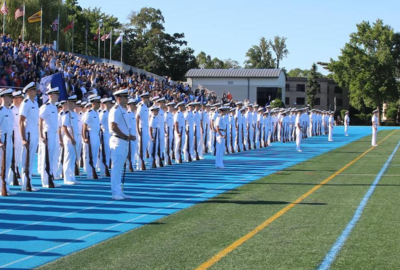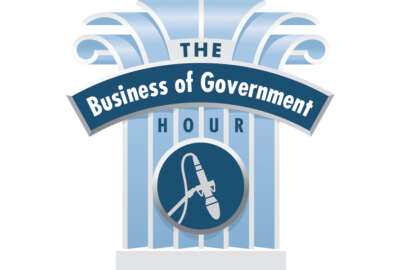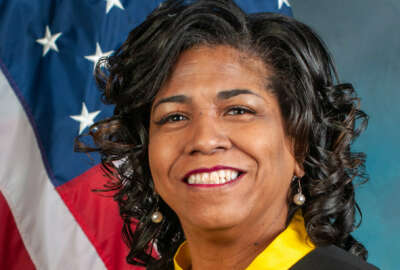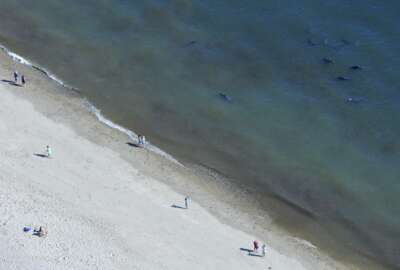How the Merchant Marine Academy can get past the sexual assault problem at sea and everywhere else
The National Academy of Public Administration led a detailed review of the sexual assault and sexual harassment problems at the U.S. Merchant Marine Academy.
Best listening experience is on Chrome, Firefox or Safari. Subscribe to Federal Drive’s daily audio interviews on Apple Podcasts or PodcastOne.
The sexual assault and sexual harassment problems, known as SASH, we just heard about came up in a detailed review of the U.S. Merchant Marine Academy. It was done at congressional request by the National Academy of Public Administration. Leading the study was Judith Youngman, a NAPA fellow and former faculty member of both the Coast Guard and U.S. military academies. Youngman spoke to the Federal Drive with Tom Temin.
Interview transcript:
Judith Youngman: Our response around findings and analysis and recommendations on SASH and sea year are really multi dimensional. One of the most important findings about SASH is that, as with all other major management and governance issues, and its oversight bodies, including MARAD into DoT, the academy did not have the capacity or the capabilities to really effectively address SASH. Not only SASH response, but SASH prevention, then SASH response, and then providing those who were harassed or assaulted with the mental health or other support that they need. So we found a lot of gaps in capabilities and incapacity that go back many years. This is not a new problem. And as you probably know, sea year was also halted just a few years ago. And of course, when this one new reported incident came out in October, it was immediately halted again. Between those two events, both the academy and the Department of Transportation and MARAD did take some actions, as well as even before the 2015-2016 era, back in even 2012, recognizing that they needed more tools and policies than were already there. And one of the drivers of that in another finding of our report is that there is a real gap at the academy on SASH overall between the number of incidents that are specifically reported, and then the surveys taken by the Department of Defense and other organizations that are surveys of the midshipmen themselves. And the surveys of the midshipmen themselves reveal much higher greater incidents of SASH than the official report.
Tom Temin: There’s really two separate issues than here. The sexual assault, sexual harassment, happening at the academy is one thing, which is right under their nose, versus those incidents that happen aboard ships during the sea year beyond the reach, at least in an immediate sense, of the academy.
Judith Youngman: One little correction — I wouldn’t say necessarily happening at the academy, because if you go into the DoD data banks, the Office of People analytics, what you find is about half of the incidents that are reported or shared in surveys did not happen at the academy. They happened to midshipmen perhaps while they were other places engaged in their training and development processes. And actually, that is comparable to what the other service academies find. So it’s not necessarily on academy grounds. And I think that that’s important to know. But what it gets at is a really more fundamental issue. And I think many people do not realize this or understand this about the federal service academies. The federal service academies — all of them, and this includes the Merchant Marine Academy — are really revolving doors of people, even more so than a college or university or any military unit. You have, every year, you know, a whole new class of students coming in. You have a revolving door of especially training staff, you have a revolving door of some coaches, you have a revolving door among the faculty. And the key is that building a culture that says SASH is not acceptable at this institution. At the federal academies, it is essential that it be a consistent ongoing annual process with clear statements against SASH, above SASH, that express a zero tolerance for SASH coming from senior leaders not just from the academy, but senior leaders from the Department of Transportation and also MARAD, and as we’ve seen, the Congress as well. But more importantly, there must be structured programs run by professionals that are constant, because you are constantly re-training. We’re training new people entering that culture. Those who have been assaulted and even harassed, often are afraid of reporting, afraid of repercussions, if they don’t feel safe in their own cultural community and in the academy environment, including the Merchant Marine Academy. What is really important, the only chance you have at being effective in your SASH programs, is tying them to the academy’s values, tying it to their mission, tying it to their leadership structure, and also tying it to the performance expectations for every member of the academy community. And until you create that safe cultural environment, you will have that discrepancy between survey data on sash and what’s actually recorded.
Tom Temin: And we mentioned that most of the sash, or a great deal of it, does not happen on Maritime Academy grounds. Aside from the sea year, where people are on privately owned, but U.S. flagged ships doing training, where then can it happen, other than the academy that’s academy-related. Where does it go on, the SASH?
Judith Youngman: Well, I think if you want the data, it’s on the DoD, it’s in the public domain. So I think you can get the data of where it would be. But at all the academies, cadets and midshipmen train outside of the academy grounds. So I think that that’s just other places that they are. They’re not like college students who get a nice long summer break, so they are kind of in school except for their leave time.
Tom Temin: Where then could they be where these occur that are academy and education-related, but not on a sea year ship or on the academy grounds, then?
Judith Youngman: Well, midshipmen at the Merchant Marine Academy, just like students at a lot of colleges and universities and certainly the other service academies, are engaged in other activities that are part of that program. It could be part of training at some other location. It could be part of academic conferences, events at other institutions. It could be part of athletic events at other institutions. So they’re constantly on the move. And it’s also important to keep in mind that, unlike other college students, cadets and midshipmen at the federal academies are engaged 12 months a year, except for a modest leave time.
Tom Temin: And at the sea year, then, what tools do you feel and what did the panel look at? What kind of influence can it exert, the academy, over these ships, which are part of a different sort of international culture, if you will? And they’re out of the immediate reach of law enforcement unless the Coast Guard boards them or something. How do you deal with that one? Because you need to see here, and yet the ships apparently are dangerous territory for young people.
Judith Youngman: Well, I’m not characterizing them as necessarily dangerous. But I think that, I think in a way to answer your question, is to compare what is there now to what was there prior to the earlier halting of sea year, because things were done in the interim. Obviously, they were not sufficient things, but things were done in the interim. It is not just an academy responsibility. And part of the reason why is because number one, the academy doesn’t have the capacity and the capabilities to do a lot of this. But what was done in the interim was first of all, the academy did listen, they did take action. One of the actions was to ensure that the midshipmen, before they reported to their commercial vessel during sea year, had access to and was aware of that company’s policies and procedures in place regarding fashion, especially sexual assault. They set up a satellite phone system because when you were at sea, you are not always connected to the internet. So they set up a satellite phone system so that every midshipmen at sea has a way to contact the academy directly and they have the points of contact that they can contact, should they need assistance, help or want to be removed from the ship or that kind of thing. The academy also — I guess the brief is the word — brief the midshipmen before they departed, and also communicated with the midshipmen before they returned. But the key is the academy doesn’t have the authority to make demands on a shipping company, even a U.S. flagged vessel.
Copyright © 2024 Federal News Network. All rights reserved. This website is not intended for users located within the European Economic Area.
Tom Temin is host of the Federal Drive and has been providing insight on federal technology and management issues for more than 30 years.
Follow @tteminWFED








